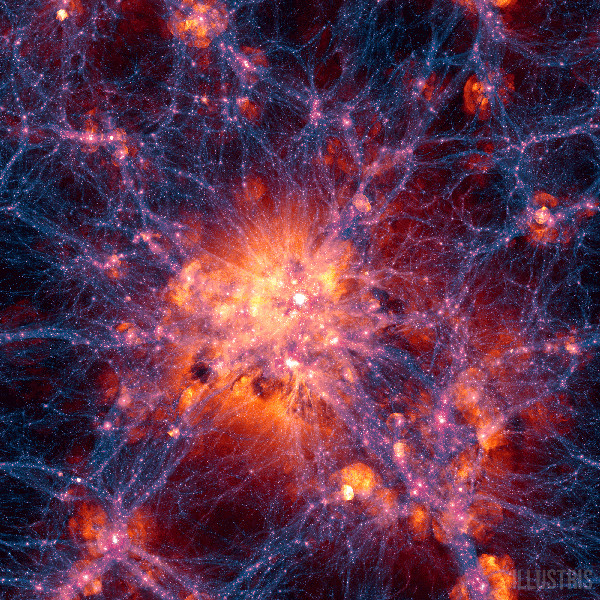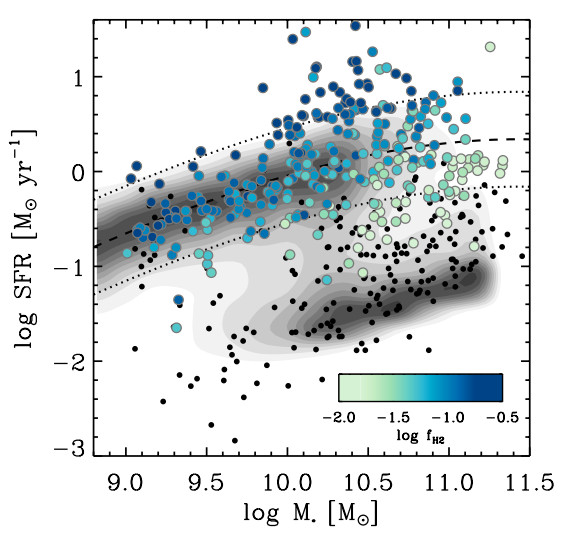Professor of Astrophysics

Research
The role of gas in galaxy evolution
Despite their enormous sizes and some of their stars being almost as old as the Universe itself, galaxies are dynamic systems that constantly evolve. Galaxies grow through the interplay of a range of physical mechanisms that affect their ability to form new generations of stars and transform their shapes.
The new ability of millimeter-wave telescopes to detect the faint emission from molecules in distant normal star-forming galaxies when the Universe was only 2 billion years old has been key in shaping our current picture for galaxy evolution; it is showing us how gas is the lifeblood of galaxies. Most of the evolution of galaxies is shaped by the flows of gas that feed them, the efficiency of the star formation process out of the gas that settles into the galactic discs, and the outflows, powered by stars and supermassive blackholes, that return gas to the external environment.

A massive galaxy cluster from the Illustris Simulation, showing how the dark matter cosmic web and the flows of gas extend far beyond the galaxies themselves.
Molecular gas in nearby galaxies
Given the importance of gas in galaxy evolution, a first step is to make a complete census of the cold gas component of galaxies. Large scale surveys at optical and infrared wavelengths have clearly established that galaxy properties such as mass, size, star formation rate, chemical composition and morphology are linked by a vast network of scaling relations. My research programme is aimed at including information about the cold gas contents of galaxies in this picture, and using it to disentangle the contribution of different mechanisms on the evolution of galaxies.
The xCOLD GASS survey, conducted at the IRAM-30m telescope, has been particularly successful in giving us this much needed global picture for how cold gas is linked to and explains other galaxy properties. Key results from the survey include the discovery of systematic variations in star formation efficiency across the local galaxy population, and the demonstration that the availability of atomic and molecular gas, combined with these variations in star formation efficiency, simply explain the distribution of galaxies along and across the main sequence of star-forming galaxies.

xCOLD GASS shows how the molecular gas contents of galaxies varies both along and across the galaxy main sequence.
Dust as a cold ISM tracer
We still face a significant technical challenge: the observations required to measure the molecular gas contents of galaxies (especially distant ones), are complex and time-consuming. Furthermore, to make significant progress in our ability to relate the properties of the cold interstellar medium and galaxy evolution processes, we need to refine the accuracy of our gas measurement techniques.
It is widely known that the most popular cold molecular gas tracer, the CO molecule, behaves poorly in dust-poor galaxies. This is a challenge if we want to extend the type of work done with xCOLD GASS to even lower mass dwarf galaxies, and/or to galaxies at very high redshifts.
My research group is investigating alternative tracers of the cold ISM, with the aim to calibrate a range of methods to measure the molecular gas contents of galaxies. This includes the use of radiative transfer modeling to investigate the behaviour of far-infrared fine structure lines such as [CII], which has made possible the calibration of a new multi-variate CO-to-H2 conversion function.
Our most recent observational endeavour is JINGLE, a large programme ongoing at the James Clerk Maxwell Telescope (JCMT). JINGLE targets both the gas and dust contents of a large sample of nearby galaxies, allowing us to benchmark relations between the dusty ISM and global galaxy properties, and quantify systematic variations of quantities such as dust temperatures and emissivities across the local galaxy population.

A new multi-variate CO-to-H2 conversion function derived by Accurso et al. (2017) using data from the Herschel space telescope and the IRAM 30-m telescope.